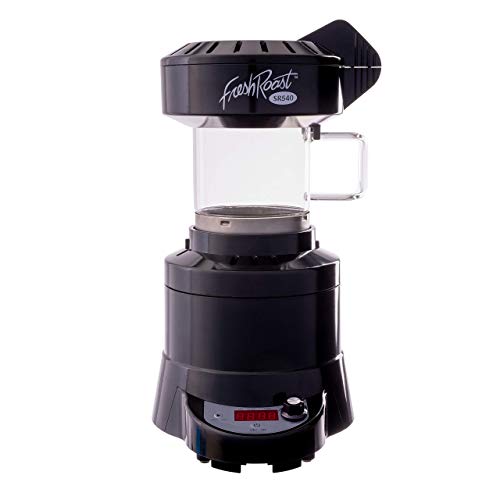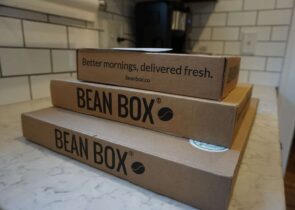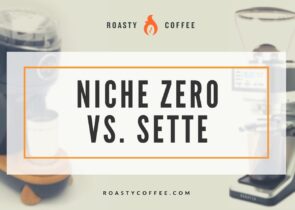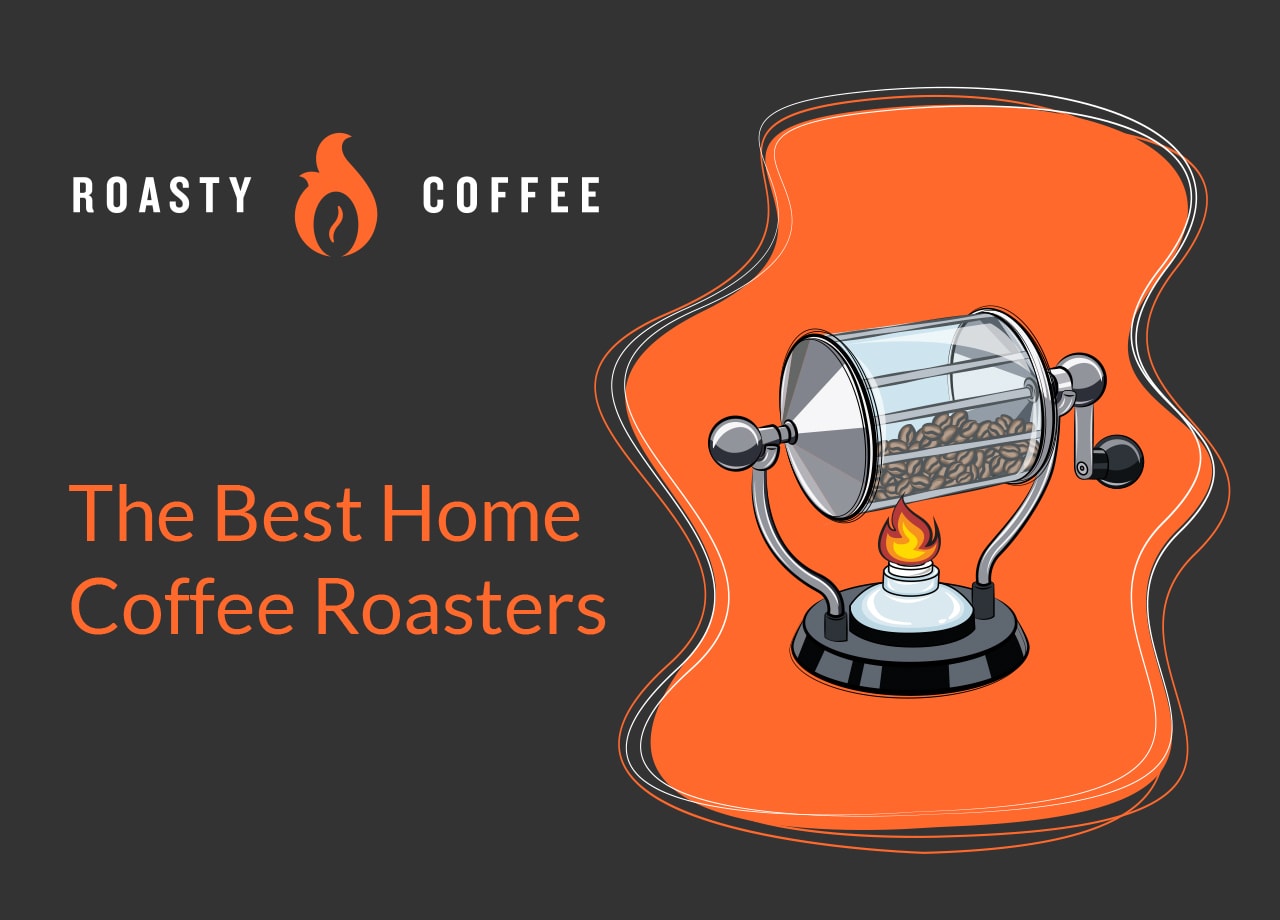
If you’re anything like us, you take your coffee pretty seriously. The right batch of beans, the right coffee grinder, the right cup…all these things matter when you’re in love with liquid bliss.
But here’s something you might not have considered to improve your brew: buying a coffee roaster and roasting fresh green coffee beans at home.
At a Glance: Our Top 5 Picks For Best Home Coffee Roasters
Why roast at home?
Pre-roasted coffee can be delicious, but even the best batch of coffee begins to lose its rich flavor and aroma just a few moments after roasting. If you’re a coffee drinker who’s ready to enjoy the ultimate home-brewing experience and sip a fresher, tastier cup, it’s time to heat things up with a roaster of your very own.
Quick Summary: Best Home Coffee Roasters
 | Our Top Pick KALDI WIDE HOME COFFEE ROASTER |
| Check On Amazon → |
 | JIAWANSHUN ELECTRIC COFFEE ROASTER |
| Check on Amazon → |
 | FRESH ROAST SR540 COFFEE ROASTER |
| Check On Amazon → |
 | NUVO ECO HANDY CERAMIC COFFEE BEAN ROASTER |
| Check on Amazon → |
 | HARIO RETRO COFFEE ROASTER |
| Check on Amazon → |
 | NESCO 4818-12 CLASSIC ROASTER OVEN |
| Check on Amazon → |
 | GREAT NORTHERN POPCORN STAINLESS STEEL STOVE TOP POPPER |
| Check on Amazon → |
 | DYVEE GAS COFFEE ROASTING MACHINE |
| Check on Amazon → |
 | CAFEMASY COFFEE BEAN ROASTING NET |
| Check on Amazon → |
Our Favorite Coffee Roasters
In this coffee roaster review, we took the guesswork out of it for you and found a handful of the best roasters in the coffee industry that offer all the features you need. Some are rather basic but take up less space. Others are more advanced models and you might have to rearrange your countertop to give it a good home. Either way, we think you’ll like the choices we have made for your reading pleasure. You’re welcome.
Kaldi Wide Home Coffee Roaster
If you’re looking for a more high-quality roasting machine to trust your beloved coffee beans with, then look no further than the Kaldi Home Coffee Roaster. Though it’s somewhat pricier than a typical countertop device, this is one of the more advanced roasting devices on the market. The Kaldi is an extremely well-made, highly industrial machine that’ll get the job done every time.
Built with a strong body, thermometer, bean hopper, probe rod for accurate temperature measurements, and a compartment for coffee dandruff, or chaff, collection, the Kaldi is a spectacular choice if you’re looking for an above-average coffee roasting machine. It requires a gas burner for heat, but there’s also a free volt adapter included, and it’s also able to roast up to 300 grams of beans at once.
JIAWANSHUN Electric Coffee Roaster
Sleek in design and affordable for many, the JIAWANSHUN Electric Coffee Roaster has two different models for you to choose from, 110 or 220 volts. It has a non-stick chassis, making it simple and hassle-free to clean.
Where roasting power is concerned, it’s able to hold a little over one pound of coffee per roast, as well as roast anywhere between 212 to 464 degrees Fahrenheit (100 to 240 degrees Celsius). Unfortunately, the roaster’s adjustable temperature controls are only measured in Celsius, but this is something you’ll adjust to in no time.
Additionally, the JIAWANSHUN also has automatic constant temperature heating to ensure your coffee beans are roasted equally and adequately. Not only is it great for roasting coffee, but it’s also fantastic for popping popcorn, roasting peanuts, and more.
Fresh Roast SR540 Coffee Roaster
More advanced than its older SR500 sibling, the FreshRoast SR540 is compact enough for any size kitchen and durable enough to last you for the long haul; you’ll be roasting your favorite coffee beans with it for years to come.
This impressive machine has a small footprint, but several advanced features. Some of our favorite automatic features include a real-time temperature display, as well as nine different levels of fan and temperature settings.
Not only is the FreshRoast SR540 simple to navigate and extremely user-friendly, but it can also roast four ounces, or 120 grams, of coffee per sitting. And if that wasn’t enough, this machine comes with a one-year warranty, giving you all the quality with a steady peace of mind.
Nuvo Eco Handy Ceramic Coffee Bean Roaster
Like exercise, a good cup of coffee can leave you feeling energized and refreshed. So why not combine coffee roasting with a modest workout for the best of both worlds? The Nuvo Eco Ceramic Handy Coffee Bean Roaster needs only two things to produce tasty roasted beans: fire and your willingness to bust a move while you roast.
This manual coffee roaster holds up to 70 grams of coffee (2.5 ounces) per batch over an open flame. You won’t be roasting for a crowd, but the uniquely textured “waffle” interior and cha-cha roasting moves mean you’ll have a blast while you’re prepping your morning brew. If you’re a coffee traditionalist who’s into functional art, manual roasters, and are brewing for one or two on the daily, you might just fall in love with this one.
Hario Retro Coffee Roaster
Good coffee is art. And if you want to feel like you’re part of an artisanal coffee revolution, few things beat gently turning this retro-style glass roaster over an open alcohol flame as you watch your coffee beans roast. Quietly humming Mumford & Sons songs while you’re at it is optional, but recommended.
Holding just 1.8 ounces, or 50 grams, of beans per batch, this Japanese coffee roaster emphasizes patience, artistry, and small-batch craftsmanship. Its unique design makes it something of a conversation piece and a decor item as well. If you want every cup you brew to be not just a beverage but an experience, this one’s for you.
NESCO 4818-12 Classic Roaster Oven
Harness the power of advanced coffee roasters — without the professional price tag, mind you — with this behemoth from Nesco. It’s rocking 1425 watts of power and holds up to 18 quarts (17 liters), so it could crisp up your Thanksgiving turkey as easily as it roasts your coffee beans. It can handle serious heat up to 450 degrees Fahrenheit (232 degrees Celsius) so you can tinker with your roasting recipes in endless ways as you pursue the perfect cup of coffee.
This electric model has a large footprint and needs plenty of room on the counter. With its moderate price tag and powerful, flexible roasting options, it’s a good choice if you’re roasting large amounts of coffee frequently and want some leeway in the quantity and quality of your roasted beans.
Great Northern Popcorn Stainless Steel Stove Top Popper
Roast coffee like the cowboys did. Or at least over a camp stove like your great-grandparents did, back in the ’50s. If you prefer the hands-on approach and want a high-capacity, versatile dual-use item, roasting your coffee beans in a stainless steel beauty like the Great Northern Popcorn Stainless Stove Top Popper is a no-brainer.
With a built-in stirring system, this handy gadget makes it easy to give your beans an even roast. It’s easy to clean and store, too, so it doesn’t steal any valuable counter space when it’s not in use.
DYVEE Gas Coffee Roasting Machine
If you’ve just begun your coffee roasting journey and you’ve got a gas stove, this coffee roaster from DYVEE could be the perfect addition to your coffee kit. Plus, thanks to the roaster’s transparent quartz drum, you can watch all the action.
Though the roaster can hold 400 grams of beans, you’ll get the best results from only adding 200 to 300 grams at a time. You don’t have to limit your use of this machine to get fresh roasted coffee, though. This machine, with its stainless steel frame and base, is strong enough to handle any of your roasting needs, from coffee beans to nuts to seeds.
Cafemasy Coffee Bean Roasting Net
You don’t necessarily need an expensive roaster to up your coffee experience, and the Cafemasy Coffee Bean Roasting Net proves it. It may not look like much on the surface, resembling the small kitchen strainer you have banging around in a drawer, but this little manual roaster could become the most valuable tool in your coffee gear arsenal.
For best results, pour about 50 grams, or 1.8 ounces, of beans into the stainless steel wire mesh — a perfect option for small-capacity coffee lovers. And as you roast the beans over a burner flame, the long wooden handle blocks the heat and keeps you safe.
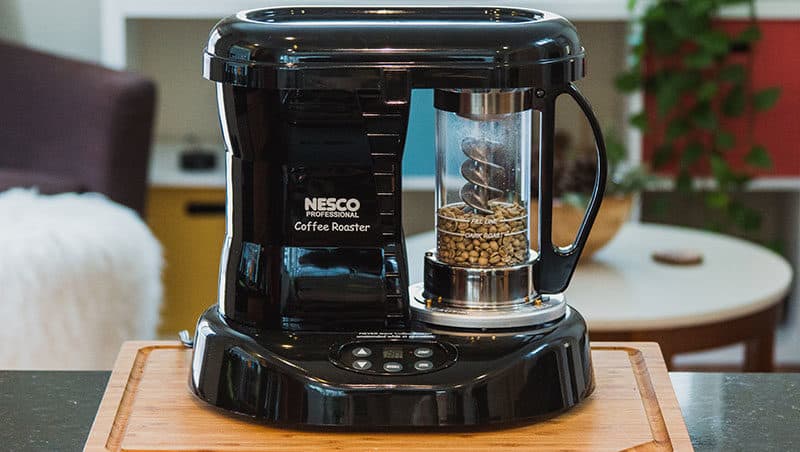
Benefits of Home Roasting
As coffee lovers, we tend to enjoy getting the most control possible over our brews. Whether it’s investing in a semi-automatic espresso machine or perfecting the meticulous yet rewarding art of pour-over coffee, we crave that artisanship. But is it worth it to go the extra mile and roast your own beans?
If you want to make your own blends, then it’s absolutely worth it. If you’re the roaster, you can combine beans from different origins with varying flavor profiles and create the brew of your dreams, which is pretty cool.
You also get to control the roasting time and level. As we’ll get to in the guide below, there aren’t really exact standards on getting perfect light, dark, or medium roasts; every roaster does things differently. However, if you are roasting your own coffee, you know exactly what you are getting, and with some practice, you can make your blend perfect for you.
Plus, as coffee experts can attest, roasting beans is just plain fun! We’ve all got hobbies and need some me-time, and roasting your joe allows you to put a little bit of your time aside to make something you enjoy. And that can be incredibly rewarding…not to mention it’ll help you get your mind off of life’s other stresses.
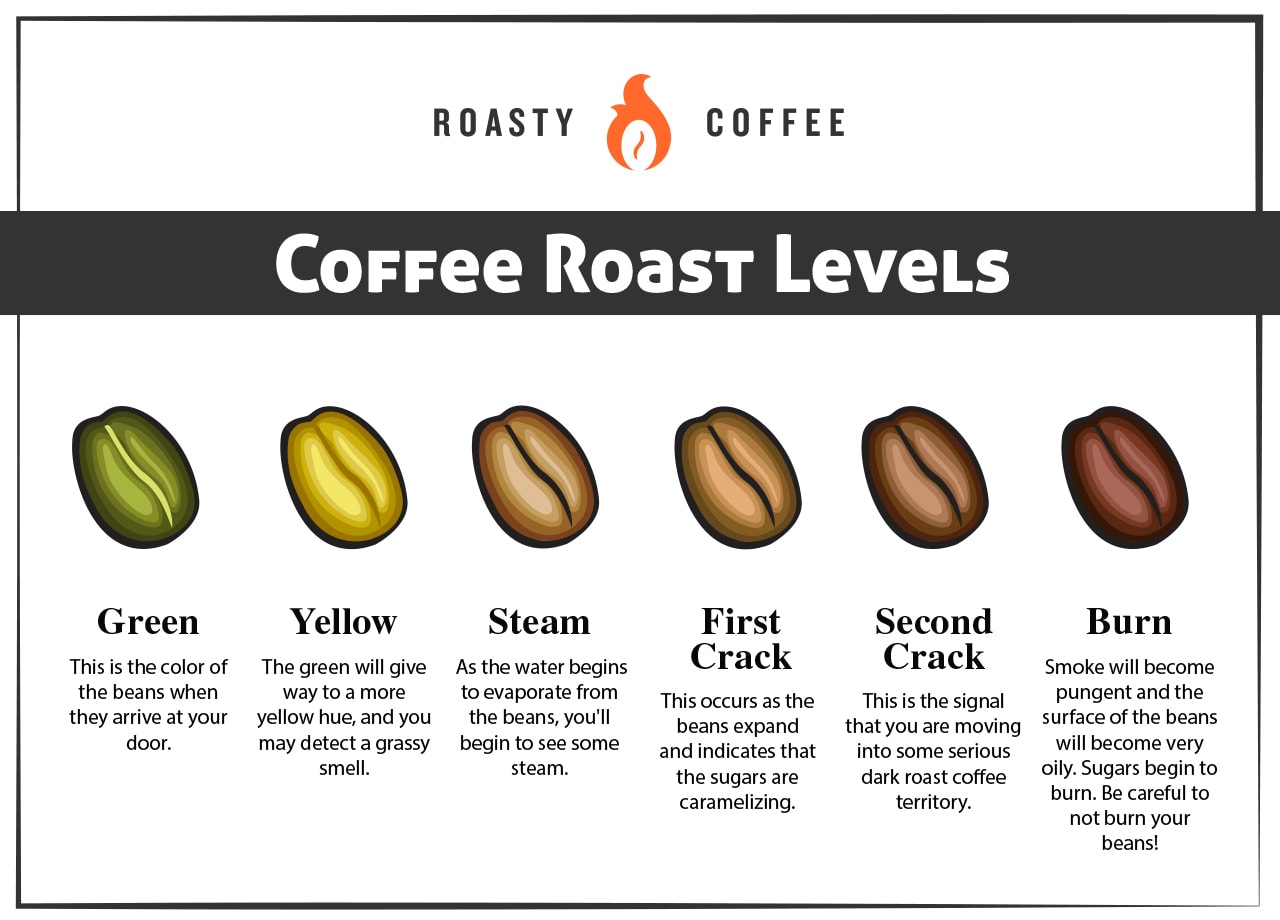
The Basics of Coffee Roast Levels
Just so you have an idea of what to expect when you are roasting coffee beans, here is a basic run-down of the different roasts of coffee:
- Green: This is the color of the beans when they arrive at your door. They’ll keep it for a short time as you begin roasting.
- Yellow: The green will give way to a more yellow hue, and you may detect a grassy smell.
- Steam: As the water begins to evaporate from the beans, you’ll begin to see some steam. Some roasters have steam or smoke suppression technology, but the process is still unlikely to be completely smoke-free.
- First Crack: After a bit of steam, you’ll start to hear a cracking sound. This occurs as the beans expand and indicates that the sugars are caramelizing. After the first crack, your beans’ roast level will run from City to Full City before reaching the next stage. They will range from pretty light-medium to medium-dark in color but should remain mostly dry-looking.
- Second Crack: As the beans roast more you will encounter a second, more violent crack. This is the signal that you are moving into some serious dark roast coffee territory. You may be able to see some spots of oil on the bean surface. However, we wouldn’t recommend extending the roast time much longer after you’ve heard the second crack as you get a more bitter flavor the longer you roast.
- Burn: As the roast continues following the second crack, the smoke will become pungent and the surface of the beans will become very oily. Sugars begin to burn, and if you keep going, not only will temperatures become more hazardous, but your beans will burn, which won’t be tasty.
Some Pro Tips
For beginners, we recommend waiting until just past the first crack for your beans. If you discover you want a darker roast, then go for it. But going much farther than the second crack will bring you into French Roast territory, which we don’t advise, particularly in a home setting.
Even if you do enjoy French Roasts, the amount of heat and smoke involved makes going that far on the roast inadvisable. Similarly, taking beans out before they hit the first crack is a bad idea. The fabled Blonde Roast isn’t so great for you, either.
So, we recommend sticking in the medium range and lightening or darkening slightly according to your personal preferences. This range tends to be where most people prefer their coffee anyway, as you get the most out of the beans’ regional flavors.
Types of Roasters
Popcorn Makers
Obviously, popcorn makers aren’t technically made for roasting coffee. However, they are one of the most popular options for that activity.
They aren’t perfect, as they tend to make your roast a bit uneven. But, they are the perfect beginner’s tool. Getting a manual or automatic popcorn popper will let you figure out if you enjoy the process of roasting your beans without putting much strain on your wallet.
Nonetheless, if you do decide you are for-serious with the at-home roasting, we recommend upgrading to one of the following roaster types to make your life a lot easier.
Air Roasters
An air roaster utilizes direct heat or convention, similar to a popcorn maker. It works by pushing hot air through the roasting chamber. Consequently, the heat is put directly in contact with the beans themselves.
Air roasters, like popcorn makers, tend to be relatively small in size. So they work best for people who are doing small-batch roasting. If you are just roasting for one or you want to make a variety of different roasts for the week, this is the type for you.
Drum Roasters
On the other hand, drum roasters utilize conduction or indirect heat. There is typically a rotating roast chamber inside the machine. Instead of applying heat to the beans, it is applied to the exterior of that chamber. As beans then come in contact with the heated surfaces, they begin to roast.
While air roasters are better for small batches, drum roasters tend to have larger capacities, which is great if you have a whole family of coffee drinkers or chug several cups a day yourself. But don’t let the large capacity convince you roasting in bulk is the best idea, though. To make sure you’re drinking the freshest coffee possible, we don’t recommend roasting more than what you’d need for the next week.
Know Before You Roast…
How much are you roasting?
As we mentioned earlier, different roasters have different average capacities. So before you go invest in one, take note of how much coffee you (and whoever else you’re serving) consume each week. This timeframe is ideal because we’re shooting for the utmost freshness.
Once you get your average consumption figured out, check out the sizes of the roasters you are looking at first and eliminate ones that are too big or too small. This should help you narrow your search considerably.
Does it have a cooling feature?
A cooling feature is vital if you want to get serious about your coffee roasting. If there is no cooling mechanism, beans will continue to roast after you have removed them, as their internal temperatures remain high. This could lead to uneven or over-roasted beans, which aren’t exactly ideal. Thus, a run-of-the-mill popcorn maker probably isn’t going to cut it in the long term.
DYVEE Electric Coffee Bean Cooler
Speaking of cooling your coffee beans…if you’ve purchased a roaster that doesn’t come equipped with a cooling mechanism, you might want to consider buying a separate bean cooler. And you’re in luck! To make your coffee roasting and cooling endeavors easier, we’re recommending our favorite electric cooler for you to try!
This electric cooler from DYVEE boasts a powerful fan that can cool your batch of beans in two minutes and locks in all the delicious flavors without the risk of over-roasting. Like we mentioned earlier, if you’re serious about coffee roasting, investing in a solid coffee cooler is the way to go.
How dark are you going?
Roasting darker is going to produce more smoke. While there are some safeguards in place for some machines to help mitigate this issue, at least a bit of smoke from roasting is essentially unavoidable. So if you don’t have a super well-ventilated roasting area or have a built-in smoke suppression system, do NOT go for a very dark roast.
You’ll be setting off the fire alarm and driving your family or neighbors up the wall. Also, it’s simply hazardous to be exposed to high amounts of smoke. If you are partial to the darker side of things, you need to consider that preference and seriously invest in something that’ll keep the escaped smoke to a minimum in addition to taking steps to ensure good ventilation.
Frequently Asked Questions
How much does a coffee roaster cost?
As with many products, both coffee-related and not, the price of a coffee roaster usually varies depending on the brand, size, and features.
There are reasonably-priced personal roasters available, however, if you intend to buy a commercial roaster, be prepared to shell out at least a few thousand dollars regardless of the machine’s manufacturer.
Is home roasting cheaper?
You might be wondering if roasting your beans at home is a good way to cut down on coffee costs, and if you’re an at-home brewer on a budget, we’ve got good news: the answer is yes!
In many instances, green coffee beans are much cheaper than the bag of freshly roasted whole beans you’ll buy from your favorite local roaster or café. That’s probably because they’re unprocessed, and many times, you get what you pay for. You might have to shell out the big bucks for a quality roaster, but in the long run, roasting your own beans could save you some money.
Is coffee roasting dangerous?
Yes, roasting coffee does have the potential to be dangerous. But don’t let that knowledge turn you off to giving it a try. So long as you do the proper research and discover the safety dos and don’ts of the trade, even a beginner can safely roast coffee beans.
A few hazards you should be cautious of and make every effort to avoid include burns from the hot machinery and beans and the chemicals diacetyl and acetyl propionyl that are released in the fumes and have been linked to respiratory issues…although if your roasting area is well-ventilated and you’re only doing it for short periods, the risk of developing health issues from the chemicals remains fairly slim.
How long do coffee beans need to degas? How soon after roasting can I drink coffee?
Though coffee bean degassing times (allowing the carbon dioxide to leave the freshly roasted bean before its brewed) vary based on the type and roast level of your beloved bean, most beans take from two to 12 days to degas, which means the coffee needs to rest for the same amount of time.
You may be tempted to skip this step and brew your beans as soon as they’re roasted, but remember, good things come to those who wait! If you don’t let your beans degas, the coffee extraction will be uneven during brewing, and your morning cup won’t be as flavorful.
How long do roasted coffee beans last?
As a general rule, you don’t want to dawdle when it comes to using your freshly roasted coffee beans in your coffee maker. Though the beans won’t actually “go bad” in the sense that they’ll make you sick, they do “go bad” when they begin losing flavor, which typically starts to occur seven to 10 days after they’ve been roasted.
However, you can prolong your beans’ lifespan if you store them properly (in an airtight container and away from light and moisture).
Are shiny coffee beans better?
Some coffee connoisseurs might insist that shiny coffee beans make better cups of coffee, as the shine you see is the coffee bean’s natural oils, and those are what give your morning brew the aromas, flavors, and crema you love so much.
This isn’t necessarily true, however. In fact, there isn’t necessarily a one-size-fits-all answer to this question. Since not all beans produce the same amount of oil, it’s somewhat difficult to use oiliness, or shininess, as an accurate gauge for a coffee’s freshness. Dark roasts, for example, tend to be shinier than light or medium-roasted beans.
When dealing with darker coffee, a shiny, slightly oily bean isn’t necessarily going to make it taste better or worse. But if a medium or light roast coffee is shiny and oily, it’s usually a sign the beans have been improperly stored for a long time. And if the shiny beans are no longer smooth and slick and have become sticky instead, the coffee was probably roasted a while ago…in either case, the resulting brew won’t be the best.
Get The Most From Your Roast
The best cup of coffee is one that’s made to your exacting standards. And whether you’re cuckoo for cold brew coffee or kickin’ it old school with a stovetop percolator, coffee roasters are essential to making fresh and delicious coffee at home.
Bid pre-roasted beans a not-so-fond farewell.
Roasting coffee at home adds depth, flavor, and aroma to your coffee making. It’s another way to connect with the process and tweak everyone’s favorite bean into a beverage that’s uniquely yours.
Happy Caffeinating!



